Parent Coaching & Tele-AAC

If I had a crystal ball, I wouldn’t be at all surprised if it told us that telepractice in AAC is here to stay. My guess is that when schools and clinics re-open there will still be a role for remote AAC services. That’s why I am so pleased that guest authors Jill Senner and Matthew Baud are returning to these pages to share their approach to using tele-AAC to educate and coach parents.

Tele-AAC for All
With social distancing, local shelter in place orders, and general concerns about the health of our high-risk clients who use AAC, most of us have made an abrupt transition to providing AAC therapy via telehealth. Doing direct therapy using video conferencing platforms might be going swimmingly for some clients who will sit and attentively gaze at the books, games, and other materials you present remotely. However, what about your younger clients? Or kiddos who need lots of movement? Or kiddos who have screen fatigue after a full day of e-learning? You can’t very well bounce on a ball, swing, cook a snack, or jump on a trampoline remotely… or can you?
It all boils down to reframing your approach to intervention. We have evidence that when parents are educated in strategies to support AAC, such as partner-augmented input (PAI), AAC modeling increases, parents and children become more comfortable with their devices, parents report an increase in AAC use at home, and children use more words on their devices. In essence, parent education IS the intervention… and coaching is the key to parent education.
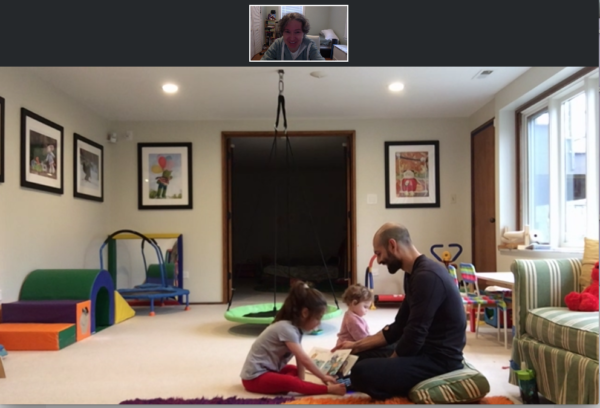
However, before we jump right into coaching during a session, parents need to understand what strategy you want them to use, why you want them to use it, and how to use it. Successful parent education programs include multiple training elements such as those found in Kent-Walsh & McNaughton’s (2005) instructional model. All of these elements can easily be provided via telehealth – either in asynchronous (i.e., recorded) or synchronous (i.e., live) formats. Some families benefit from a hybrid approach incorporating both asynchronous and synchronous training components.
We use a variety of asynchronous training materials to teach families to model AAC. To provide a description of the strategy, we use a PAI handout and a video describing what PAI is, why it’s important to use, and how to provide it. We also have shorter videos highlighting the SMoRRES (slow rate, model, respect and reflect, repeat, expand, stop) mnemonic.
Strategy Demonstration can be done by showing videotaped models of parents providing PAI at home (or using simulated models like this one of tickles). Sources for videos of parents modeling at home include:
Next, we provide controlled practice opportunities. For example, providing the parent with a list of words, phrases, or sentences to practice on the speech generating device. They can also participate in a videotaped controlled practice exercise. Interactive platforms like Seesaw, Google Classroom, or Microsoft Teams can be used to organize the materials you’re assigning.
However, simply reading handouts and watching videos is typically insufficient to change parent modeling behavior in the home. In the educational model we use, coaching the parent to use PAI with his or her child makes up the majority of instruction and is critical for generalization.
Live coaching can be provided via a videoconferencing platform, with the therapist watching the parent interact with the child engaged in an activity together such as playing on the swing, folding laundry, cooking, or jumping on a trampoline. When coaching the parent, be sure to actively listen, provide precise and informative feedback, and encourage reflection. Additional information on coaching can be found in our May 2019 post, “Coaching AAC Use in the Natural Environment.” Remember that modeling PAI for the parent during live videoconferencing is part of the coaching cycle. If you’re not sure how to do this with the technology you have, check out our tips and tricks video.
If coaching cannot be done live, fear not, it can also be conducted in an asynchronous manner. The parent can videotape a short interaction with his or her child and then upload clips to a secure file-sharing platform. Optimally, the parent would watch the video as would the therapist (not at the same time) and then the clinician would coach over the phone or email. However, evidence suggests that sooner is better than later so try to connect about the uploaded video within 24 hours if possible. 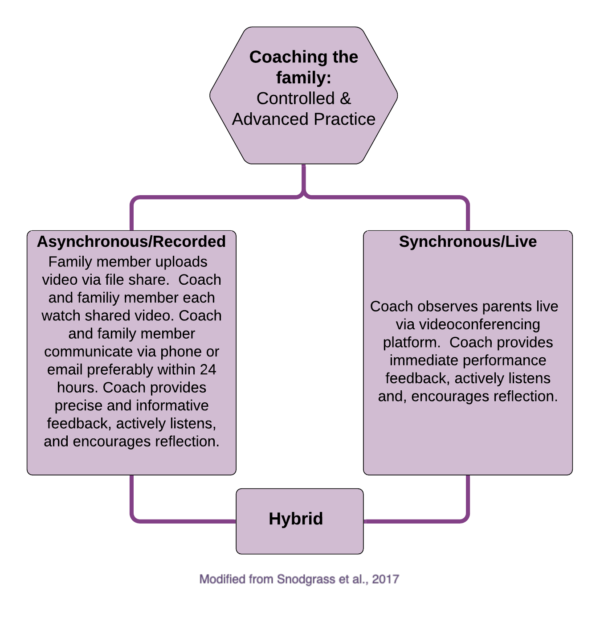
It is critical to remember that parents may be trying to work from home, may be working outside of the home, may have other children trying to do e-learning, and may have limited technology in the home that needs to be shared among family members. Furthermore, many families are experiencing a loss of supports for their child with a disability. Before assigning parent instruction, collaborate with families to find out if it’s something they want to try and get input as to a realistic amount of time they can commit to learning. One benefit of asynchronous telehealth is that it allows parents to watch and read materials at their own convenience and at their own pace, which can make a world of difference to families in these uncertain times.
Jill E. Senner, PhD, CCC-SLP is a speech-language pathologist with over 20 years of experience working with children with complex communication needs. She is the owner/director of Technology and Language Center where she specializes in providing augmentative and alternative communication (AAC) and assistive technology (AT) services including assessment, consultation and training, and workshops/lectures. Dr. Senner has presented at numerous national assistive technology conferences and has taught graduate courses in AAC and swallowing disorders. She has published research in the areas of AAC, siblings and disability, and swallowing disorders in cerebral palsy.
Matthew R. Baud, MS, CCC-SLP, has been working with AAC for over 15 years. He currently is the Assistive Technology Coordinator at Niles Township District for Special Education (NTDSE) performing evaluations, trainings and coaching communication partners. Matthew also has his own AAC private practice working with individuals with complex communication needs from birth through adulthood. He is an adjunct professor at Saint Xavier University where he teaches a graduate course in AAC and has presented at national and state conferences. Matthew has published research in the area of AAC.
You can learn more from Jill and Matt here.
Filed under: Featured Posts, PrAACtical Thinking
Tagged With: coaching, parent training, telepractice
This post was written by Carole Zangari


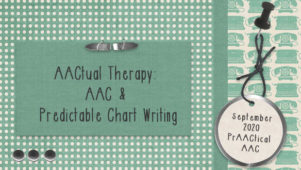
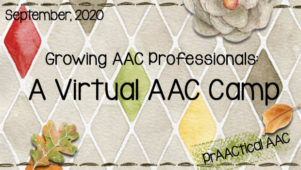
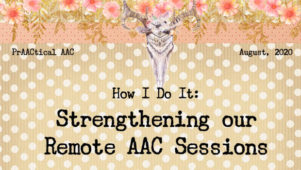
1 Comment
Thanks so much for this article! This is the approach we are taking with many of our patients. I also find myself referring people to the two of you at least weekly. I love your approach and find it easy to explain and implement. Getting ready to roll it out in a new school district next Fall and am SURE telepractice will be a big part of our journey!! Thank you!!